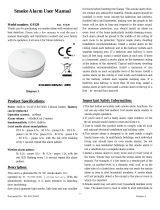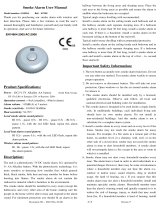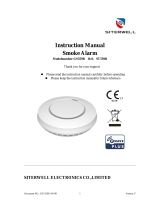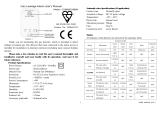Page is loading ...

Document NO.: RD-536-39-001 Version: C
- 1 -
Smoke Alarm Device User Manual
Model number: GS536 Ref:ST536
Thank you for purchasing our smoke alarm device. Please
take a few minutes to read the user’s manual thoroughly and
familiarize yourself and your family with its operation. And
save it for future reference.
Diagram 1
Product Specifications:
POWER: DC9V(1604S 6F22) Carbon batteries
OPERATION CURRENT:<10uA (standby), <30mA
(alarm)
ALARM VOLUME: >85dB(A) at 3 meters.
SMOKE ALARM DEVICE SOUND PATTERN:
BI 0.5s - pause 0.5s – BI 0.5s – pause 0.5s – BI 0.5s –
pause 1.5s, with the red LED flash, repeat this alarm
pattern.
COMPLY WITH STAANDARD: EN14604:2005/AC:2008
Description:
The unit is a photoelectric smoke alarm device. With the
photoelectric technology, it is more sensitive to detecting
slow smolder fires which general thick, black smoke, a little
heat and may smolder for hours before bursting into flames.
The smoke alarm device does not contain the radioactive
material which is harmless to the environment.
The smoke alarm device should be installed in every room
(except the bathroom and kitchen), and every other area of
the home, making sure the people in the home will be able to
hear and respond to the alarm sound. For minimum
protection, you should fit an alarm respectively for the
hallways, living room, bedrooms and child rooms, each unit
shall be placed in the middle of the ceiling of each room to
protect.
Typical single storey dwelling with recommended:
Install a smoke alarm device on the ceiling or wall inside
each bedroom and in the hallway outside each separate
sleeping area. If a bedroom area hallway is more than 30 feet
long, install a smoke alarm device at each end. If there is a
basement: install a smoke alarm device on the basement
ceiling at the bottom of the stairwell.
Typical multi-storey dwelling with recommended protection.
Install a smoke alarm device on the ceiling or wall inside
each bedroom and in the hallway outside each separate
sleeping area. If a bedroom area hallway is more than 30 feet
long, install a smoke alarm device at each end install a smoke
alarm device at the top of a first – to- second floor stairwell.
Important Safety Information:
1: The test button accurately tests smoke alarm device
functions. Do not use any other test method. Test smoke
alarm device weekly to ensure proper operation.
2: If you're sure it isn't a really alarm, open windows or fan
the air around smoke alarm device for silence it
3: This smoke alarm device is designed to be used inside a
single family only. In multifamily buildings, each
individual living unit should have its own smoke alarm
devices. Do not install in non-residential buildings. And
this smoke alarm device is not a substitute for a complete
alarm system.
4: Install a smoke alarm device in every room and on every
level of the home. Smoke may not reach the smoke alarm
device for many reasons. For example, if a fire starts in a
remote part of the home, on another level, in a chimney,
wall, roof, or on the other side of a closed door, smoke
may not reach the smoke alarm device in time to alert
household members. A smoke alarm device will not
promptly detect a fire except in the area or room in which
it is installed.
5: Smoke alarm device may not alert every household
member every time. The alarm horn is loud in order to
alert individuals to a potential danger. However, there
may be some circumstances where a household member
may not hear the alarm (i.e. outdoor or indoor noise,
sound sleepers, drug or alcohol usage, the hard of hearing,
etc.). If you suspect that this smoke alarm device may not
alert a household member, install and maintain specialty
smoke alarm devices. Household member must hear the
alarm’s warning sound and quickly respond to it to
reduce the risk of damage, injury, or death that may result
from fire, If a household member is hard of hearing,
install special smoke alarm devices with lights or
vibrating devices to alert occupants.
6: Smoke alarm devices can only sound their alarms when
they detect smoke or detect combustion particles in the air.
They do not sense heat, flame, or gas. This smoke alarm
device is designed to give audible warning of a developing

Document NO.: RD-536-39-001 Version: C
- 2 -
fire. However, many fires are fast - burning, explosive, or
intentional, and others are caused by carelessness or safety
hazards. In this circs, Smoke may not remake the unit
alarm QUICKLY ENOUGH to ensure safe escape.
7: Smoke alarm devices have limitations. This smoke alarm
device is not foolproof and is not warranted to protect lives
or property from fire. Smoke alarm devices are not a
substitute for insurance. Homeowners and renters should
insure their lives and property. In addition, it is possible for
the smoke alarm device to fail at any time. For this reason,
you must test the smoke alarm device weekly and replace
unit every one year.
Battery Connections:
Diagram 2
Battery Specification:
Carbon Zinc Battery:
Gold Peak:GP1604S 9V by GP International (Shen
zhen).LTD
Raymax:6F22 9V by Zhejiang Mustang Battery Co., Ltd
Replace Battery:
1: Turn the alarm body counterclockwise and take out the
alarm body from the bracket.
2: Take out the old battery, connect the new battery to power
connector.
3: Fix the battery into battery box, fit alarm body on bracket
and turn the alarm body clockwise. (see Diagram 3).
4: Test smoke alarm using test button. The sound
pattern is 3 short beeps-pause 1.5 seconds, repeat it.
If there’s no sound output, it means that the smoke
alarm is faulty or the installing operation is wrong,
and you can get helps from the section: “trouble
shooting”.
WARNING:Test the alarm for correct operation
using the test facility whenever the battery is replaced
Diagram 3
Do Not Install Smoke alarm devices in
the Following Places:
1: Near appliances or areas where normal combustion
Regularly occurs (kitchens, near furnaces, hot water
heaters). Use specialized smoke alarm device with
unwanted alarm control for this areas.
2: In areas with high humidity, like bathrooms or areas near
dishwashers or washing machines. Install al least 10feet
away from these areas.
3: Near air returns or heating and cooling supply vents.
Install at least 3 feet away from these areas. The air could
blow smoke away from the detector, interrupting its
alarm.
4: In rooms where temperatures may fall below 0℃or rise
above 40℃, or in humidity higher than 93%. These
conditions will reduce battery life or cause a fault alarm.
5: In extremely dusty, dirty, or insect – infested areas
influence particles interfere with smoke alarm device
operation.
Operation:
Testing
Power on the alarm is mounted on bracket .Test the unit to
ensure proper operation by pressing the test button, this will
sound the alarm if the electronic circuitry, Bracket is
mounted , horn, and battery are working .If no alarm sounds,
there is a defective battery or other failure, you can refer to
“Trouble shooting” section for solution.
DO NOT use an open flame to test your alarm, you could
damage the alarm or ignite combustible materials and start a
fire.
CAUTION: Due to the loudness (85 decibels) of the alarm,
Always stand an arms-length away from the unit when
testing.
Test the alarm weekly to ensure proper operation. Erratic or

Document NO.: RD-536-39-001 Version: C
- 3 -
low sound coming from your alarm may indicate a defective
alarm, you can refer to “Trouble shooting” section for
solution.
NOTE: WEEKLY TESTING IS REQUIRED.
LED indicators
This alarm is equipped with a red LED indicator, with two
modes of operation
Red LED-Flashing every 32 seconds: indicates that thesmoke
alarm is operating properly.
RED LED-Flashing: when the Test button is pressed, or
when the smoke alarm sense particles of combustion and
goes into alarm(constant pulsating sound),the red LED will
flash once per second. The flashing LED and pulsating alarm
will continue until the air is cleared
Fault indication - The unit will generate a "chirp" between
two flashes every 32 seconds when the unit goes into fault
mode.
NOTE: WEEKLY TESTING IS REQUIRED.
DANGER: If the alarm sounds, and it is not being tested, it
means the unit is sensing smoke, THE SOUND OF THE
ALARM REQUIRES YOUR IMMEDIATE ATTENTION AND
ACTION.
Maintenance and Cleaning:
In addition to weekly testing, the alarm requires periodic
cleaning to remove dust, dirt, and debris.
Clean the alarm at least once a month to remove dust, dirt, or
debris.
Use a vacuum cleaner with the soft brush, vacuum all sides
and covers of smoke alarm device.
This alarm has a low battery monitor which will cause the
alarm to “chirp” approx every 32 seconds and the red LED
flash once at the same time for a minimum of thirty days
when the battery gets low.
If there is a defective battery or other failures, you can refer
to “Trouble shooting” for solution, if there are still failures
during warranty, you can return to your retailer..
IMPORTANT: Do not attempt to remove the cover to clean
inside. This will affect warranty.
Repair:
Caution: Do not attempt to repair the alarm. It will affect
your warranty.
If the alarm is not operating properly, and is still under
warranty, return it to the original place you buy. Pack it in a
well-padded carton, and ship to the original place you buy.
If the alarm is no longer under warranty, have a licensed
electrician replace it immediately with a comparable alarm.
Trouble shooting:
Problem Method of disposal
Smoke alarm device
does not sound when
tested.
1. Fit the alarm on the bracket
and turn the alarm body
clockwise, until matching
well on the bracket.
2. Clean smoke alarm device.
Please refer to the
“maintenance and cleaning”
section.
3. If there are still failures
during warranty, you can
return to your retailer.
4. If the unit is out of warranty,
please replace another new alarm.
The alarm “chirp” with
red LED flashes once
every 32 seconds.
The battery is under low battery
status, please replace the smoke
alarm device.
Smoke alarm device
chirp occurs every
32 seconds(alarm goes
into fault mode).
Clean smoke alarm device. Please
refer to the “maintenance and
cleaning” section. Purchase and
change another smoke alarm
device if the problem still exist
Smoke alarm device
sounds unwanted
alarms intermittently or
when residents are
cooking, taking
showers, etc.
1. Press test button to pause
alarm.
2. Clean smoke alarm device.
Please refer to the
“maintenance and cleaning”
section.
3. Move smoke alarm device to
new location and press test
button.
The alarm sounds
different from it is used
to. It starts and stops.
1. Clean smoke alarm device.
Please refer to the
“maintenance and cleaning”
section.
2. If there are still failures during
warranty, you can return to
your retailer.
3. If the unit is out of warranty,
please replace another new alarm.
Practice Fire Safety:

Document NO.: RD-536-39-001 Version: C
- 4 -
If the alarm sounds, and you have not pushed the test button,
it is warning of a dangerous situation, your immediate
response is necessary. To prepare for such occurrences,
develop family escape plans, discuss them with all household
members, and practice them regularly.
1: Expose everyone to the sound of a smoke alarm device
and explain what the sound means.
2: Determine two exits from each room and an escape route
to the outside from each exit.
3: Teach all household members to touch the door and use an
alternate exit when the door is hot, instruct them not to
open the door if the door is hot.
4: Teach household members to crawl along the floor to stay
below dangerous smoke, fumes and gases.
5: Determine a safe meeting place for all members outside
the building.
What to Do in Case of Fire:
1: Do not be panic; stay calm.
2: Leave the building as quickly as possible. Touch doors to
feel if they were hot before opening them. Use an alternate
exit if necessary. Crawl along the floor, and do stop to
collect anything.
3: Meet at a pre-arranged meeting place outside the building.
4: Call the fire department form outside the building.
5: Do not go back inside a burning building. Wait for the fire
department to arrive.
Note: These guidelines will assist you in the event of a fire,
however, to reduce the chance that fires will start, practice
fire safety rules and prevent hazardous situations.
Where is the best to be Installed:
·At first you need install one unit in the bedroom and route
way, if you have several bedrooms, you’d better install
each alarm in every room. (see Diagram 4).
·Install it in the stairway and in every floor. ( see Diagram 5)
·Smoke, heat and burning things will spread horizontally
after rising to the ceiling, so install the alarm on middle of
the ceiling of ordinary structure house let the alarm induce
every corner.
·Install an alarm in every bedroom.
· Install an alarm in every room where large electrical
appliances are operated (for example portable heaters ).
· If alarm couldn’t be installed in the middle of the ceiling
for some reasons, the distance which the alarm away form
the wall corner should be beyond 30cm (see Diagram 6).
· Put smoke alarm at both ends of a bedroom hallway or
large room if the hallway or room is more than 9.1 m (30
ft) long.
· Install smoke alarms no slopped, peaked or cathedral
ceilings between 500 and 1500mm from the highest
point of the ceiling. Smoke alarms in rooms with ceiling
slopes greater than 1m in 8 m horizontally shall be
located on the high side of the room (See Diagram 7)
Warranty Information:
Company warrants to the original consumer.
Purchase each new smoke alarm device to be free from
defects in material and workmanship under normal use and
service for a period of 3 years from the date of purchase. This
warranty does not cover damage resulting from accident,
misuse or abuse or lack of reasonable care of the product.
In no case shall company be liable for any incidental or
consequential damages for breach of this or any other
warranty express or implied,whatsoever. The bad product
can be mailed to the following address with a detail
explanation of problem.
Installation:
·Take off the bracket from the alarm body.
·Press the bracket on the installation position, mark
installation hole of the bracket with pencil.
·Bore two installation holes on the sign with electric drill.
Make diameter of holes is 5mm, Strike the two plastic
plugs into holes with hammer.
·Attach the bracket to the plastic plugs and fix tightly the
screws into the plastic plugs. (Refer to Diagram 8).
·Fit the alarm on the bracket and turn the alarm body
clockwise, until matching well on the bracket.
·Press the button for test the unit. The alarm sounds 3
beeps – 1.5 seconds pause, repeat it until release the
button, if no sound, it indicates a defective alarm, you
can refer to ”Trouble shooting” for solution or return to
your retailer during warranty.
·If you have any questions on installation, you can contact
your retailer.

Document NO.: RD-536-39-001 Version: C
- 5 -
Diagram 6
Diagram 7
Diagram 4
Diagram 5

Document NO.: RD-536-39-001 Version: C
- 6 -
Installation sketch map:
Diagram 8
WARNING:
To prevent injury, this unit must be securely attached to the
ceiling in accordance with the installation instructions.
Manufacturer:
SITERWELL ELECTRONICS CO., LIMITED
TEL: 0086-574-87729581
FAX: 0086-574-87729581
E-MAIL: Sales@china-siter.com
No.666 Qingfeng Road, Jiangbei District, Ningbo,
Zhejiang Province,China
/




